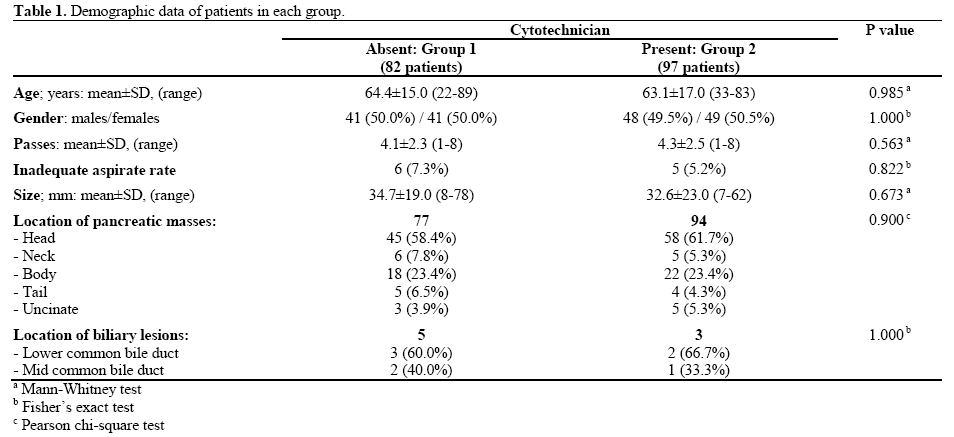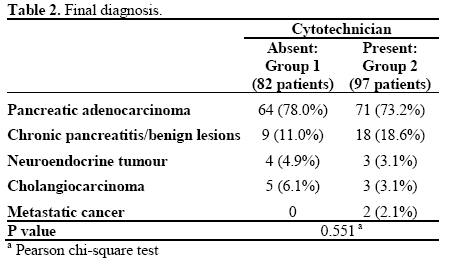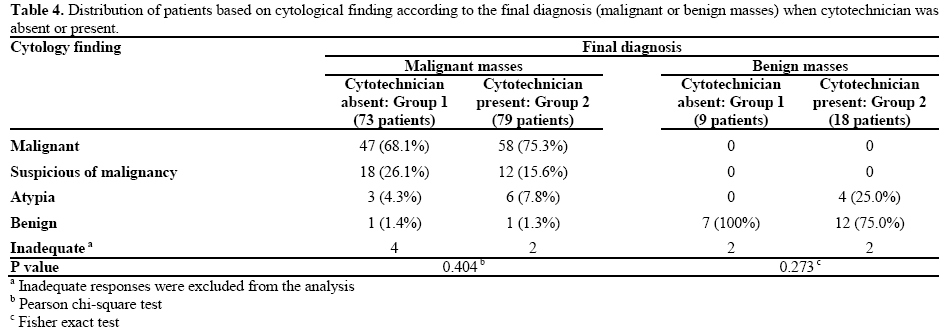- (2013) Volume 14, Issue 1
Manu K Nayar1, Suvadip Chatterjee1, Viney Wadehra2, Joanne Cunningham2, John Leeds1 and Kofi Oppong1
1HPB Unit, Freeman Hospital and 2Department of Cellular Pathology, Royal Victoria Infirmary. Newcastle upon Tyne, United Kingdom
Received November 1st, 2012 – Accepted November 27th, 2012
Context Rapid onsite adequacy assessment is stated to improve the diagnostic performance of EUS-FNA. Objectives The aim of this study was to establish if the introduction of adequacy assessment performed by a biomedical scientist (cytotechnologist) to an established EUS service improved the diagnostic accuracy of EUS guided FNA of solid pancreaticobiliary lesions. Design and Patients This retrospective study includes all patients with solid pancreaticobiliary lesions who underwent EUS-FNA from April 2009 to September 2010. An in room cytotechnologist was present for 2 out of the 4 weekly EUS lists and therefore there were two groups identified: Group 1, cytotechnologist absent; and Group 2, cytotechnologist present. Results There were 82 patients in Group 1 and 97 patients in Group 2. There was no statistically significant difference in the number of passes (4.1 vs. 4.3), the inadequate aspirate rate (7.3% vs. 5.1%) or the mean size of the lesions (34.7 vs. 32.6 mm) between the groups. The accuracy, sensitivity, specificity, positive predictive value and negative predictive value in Group 1 were 89%, 88%, 100%, 100% and 50% respectively. The results in Group 2 were 91%, 90%, 100%, 100% and 69% respectively. There was no statistically significant difference between the two groups. Conclusions In this study the adequacy assessment performed by a cytotechnologist did not improve the diagnosticaccuracy of EUS-FNA. In an established EUS-FNA service with low inadequate aspirate rates, onsite adequacy assessment may not improve results of the test.
Biopsy, Fine-Needle; Cytological Techniques; Endoscopic Ultrasound-Guided Fine Needle Aspiration; Endosonography; Pancreatic Neoplasms; Pancreatitis, Chronic
Endoscopic ultrasound (EUS) allows excellent visualization of the pancreas and the adjacent organs and has evolved as a sensitive staging modality for pancreatic malignancy [1, 2, 3, 4]. The addition of EUS guided fine needle aspiration (FNA) allows cytological diagnosis of solid pancreatic masses. This has been shown in published series to be highly accurate in diagnosing pancreatic masses with sensitivities ranging from 64 to 91% [5, 6, 7, 8]. The presence of an in room cytopathologist has been suggested as an important measure to improve the adequacy of the aspirate and therefore the diagnostic yield [9, 10]. There is robust data available from non pancreaticobiliary FNA literature on the role of onsite adequacy assessment [11, 12, 13, 14].
However, it is not clear if these benefits will be realised using a cytotechnologist (i.e. a biomedical scientist) for adequacy assessment or the impact of this on an established and experienced pancreatic EUS-FNA service.
The aim of this study is to assess the impact on diagnostic performance of introduction of an in room cytotechnologist to an established pancreatic EUS service.
This study includes all patients with solid pancreaticobiliary lesions who underwent EUS-FNA over an 18-month period from April 2009 to September 2010. Patients were retrospectively identified from a prospectively maintained EUS database. All the procedures were performed by either K.O. or M.K.N. The unit is a tertiary referral centre for pancreaticobiliary diseases for the North East of England serving a population of 3.5 million. We perform in excess of 250 pancreaticobiliary EUS-FNA of solid and cystic lesions per annum. We have been performing EUS-FNA since 2003 but did not have an in room cytotechnologist till this time period. During this period the in room cytotechnologist attended only two of the four EUS lists as there was funding available only for these lists. Patients were allocated to lists in turn and there was no influence of the presence or otherwise of the cytotechnologist. Therefore there were two groups identified:
Group 1: cytotechnologist absent;
Group 2: cytotechnologist present.
All patients were managed via a dedicated pancreaticobiliary multidisciplinary meeting. Patients with mixed solid/cystic lesions were excluded from this analysis.
EUS-FNA Technique
Patients received conscious sedation with combinations of intravenous midazolam, and pethidine under appropriate cardiorespiratory monitoring. EUS and EUS-FNA was performed using an echoendoscope (EG383OUT, Pentax, Slough, United Kingdom) and ultrasound workstation (EUB 7500; Hitachi Medical Systems, Wellingborough, United Kingdom). Twentytwo G and 25 G needles (Cook Ireland, Limerick, Ireland) were used. A standard technique was followed. The mass was identified and after staging assessment and the use of Doppler to assess for vessels, the FNA needle was passed into the lesion under EUS control. Suction was used and the needle moved within the tumour for 6-10 throws. The needle was removed and the stylet replaced to express tissue onto glass slides. One spread slide was prepared per pass and the remaining aspirate placed into cytofix red solution (BD Surepath, Bioscience Healthcare, Nottingham, United Kingdom) and processed by liquid based cytology in the cytology laboratory. The cytofix red solution lyses red blood cells and reduces debris, subsequent preparation produces a round 13 mm cellular homogenous thin layer of cells largely free from fixation and drying artefacts. On the days a cytotechnologist was present, the prepared air dried slide was stained with Diff Quick (Diff-Quick; BD Surepath; Bioscience Healthcare, Nottingham, United Kingdom) stain and their adequacy assessment based on this material. Punctures were repeated until the cytotechnologist considered the sample as adequate for providing a diagnosis. The adequacy assessment by the cytotechnician was based on the presence of pancreaticobiliary tissue. If no tissue was present then the sample was reported as inadequate. If the sample was reported as adequate then the cytotechnician would be able to comment on whether the sample had benign cells, i.e. normal tissue, atypical cells, cells highly suspicious or diagnostic of malignancy. In the absence of the cytotechnologist, it was the endosonographers discretion and assessment of the sample which helped him decide on the number of passes. The slides were air dried by the endosonographers and sent to the cytopathology department with the liquid based cytology needle rinsings for reporting.
Cytological Reporting
The final reporting was done by one of the six experienced consultant cytopathologists. Samples were graded as follows: inadequate, benign atypical, highly suspicious of malignancy, and malignant.
For the purposes of this study; highly suspicious and malignant samples were categorised as malignant.
Follow up
Final diagnosis of a malignant or benign mass was based on the following reference methods:
1) surgical histology or other biopsy methods (e.g., percutaneous sampling of the primary tumour);
2) positive cytology result combined with clinical and radiological follow-up that provided further evidence of malignancy;
3) clinical, biochemical and radiological follow-up for at least 12 months for a diagnosis of benign disease in non operated cases with benign cytology.
Written informed consent was obtained from all patients prior to the procedures. All procedures were done as a part of standard patient care and not to a research protocol and data collection was performed as part of our ongoing clinical audit (quality monitoring). Therefore institutional review body approval was not required. Normal NHS Clinical Audit Practice was observed. All aspects of the study were conducted in accordance with the Declaration of Helsinki 1964, as revised in Tokyo 2004.
Frequencies, mean, standard deviation (SD) and range were reported as descriptive statistics. The Mann- Whitney, the Pearson chi-square, and the Fisher’s exact tests were applied. Sensitivity, specificity, positive and negative predictive values, and accuracy were determined for the two groups. Diagnostic accuracy was defined as the frequency of cases correctly classified. The exact 95% confidence intervals (95% CI) of frequencies were calculated by means of the binomial distribution [15] and differences in diagnostic performance between the two groups were identified by using the Fisher’s exact test. The statistical significance was assessed at the 0.05 level (two-tailed). Statistical analysis was performed using MedCalc (version 11.3.1.0; MedCalc Software, Mariakerke, Belgium; https://www.medcalc.be/).
The demographic data and final diagnosis are as shown in Tables 1 and 2. There was equal sex distribution in both the groups. When Groups 1 and 2 were compared, none of the parameters, including inadequate aspirate rates and mean number of passes, reached statistical significance (P values greater than 0.05). The pancreatic masses were predominantly in the head and body of pancreas in both the groups. Biliary lesions were predominantly in the lower and mid common bile duct. Majority of the lesions in both groups (more than 70%) were primary ductal adenocarcinoma. The mean follow up for patients with suspected benign pathology were 17.5 months (range: 15-35 months; n=9) and 17.1 months (range: 15-32 months; n=18) in Group 1 and Group 2, respectively (P=0.942).


Table 3 shows statistical data including all solid pancreaticobiliary lesions. There was no statistically significant difference in accuracy, sensitivity, specificity, positive predictive value and negative predictive value between the two groups though the negative predictive value was numerically higher in Group 2.

Table 4 shows the distribution of patients according to cytology result. Malignant vs. benign lesions were not influenced by the presence or absence of on-site adequacy assessment (P=0.177); in fact, out of 75 adequate diagnoses of Group 1, 68 (90.7%) were malignant and 7 (9.3%) were benign, while out of 93 adequate diagnoses of Group 2, 77 (82.8%) were malignant and 16 (17.2%) were benign. Although 4 (25.0%) out of 16 benign masses were judged as atypias in Group 2 vs. none in Group 1, the statistical analysis did not show any significant difference between the two groups both within malignant (P=0.404) and benign lesions (P=0.273).

Finally, there were no complications in either group.
EUS provides excellent imaging of the pancreas and is a sensitive staging test for pancreaticobiliary malignancy [1, 2, 3, 4]. EUS-FNA has been shown to be highly accurate in obtaining tissue with an average sensitivity of 85% and accuracy of 88% in published series [7]. However good test performance is not invariable and poor performance has been reported [16]. Factors that could influence the diagnostic performance of EUS-FNA of the pancreas include the experience of the endosonographer and reporting cytopathologist, the number of passes, sample preparation, the availability of onsite cytopathological assessment and the prevalence of chronic pancreatitis where tissue can be difficult to obtain making cytopathological interpretation difficult [17, 18, 19, 20, 21, 22, 23, 24]. Optimising the performance of a service requires careful attention to all of these different variables. The perceived benefit of onsite cytopathological evaluation is to reduce or eliminate the unsatisfactory aspirate rate therefore ensuring that representative and potentially diagnostic material is sent to the laboratory. FNA’s of the lesion are performed until the cytotechnologist as in this study or cytopathologist deems the material to be adequate. There are robust data on the role of in room cytopathologist improving the diagnostic accuracy of lymph nodes, breast, thyroid and lung masses [11, 12, 13, 14].
The data on the role of pancreatic FNA is less clear cut, with some studies utilising a cytopathologist [7, 25, 26] others without any onsite adequacy assessment [27, 28, 29, 30] and some authors utilising an in room cytotechnologist [31, 32, 33].
Klapman et al. [25] compared two sites with (centre 1) and without (centre 2) an in room cytopathologist present in all patients undergoing EUS-FNA for any gastrointestinal and mediastinal lesions. One-hundred and ten out 195 patients had EUS-FNA of the pancreas (56.4%). The overall accuracy was 81% if both positive and suspicious samples, i.e. grade 4 and 5 were included, and 78% if only grade 5 was included as positive in centre 1 and 68% and 52%, respectively for centre 2. The unsatisfactory aspirate rate was higher in centre 2 as compared to centre 1 (20% vs. 9%). They concluded that an in room cytopathologist is a vital component of the EUS-FNA procedure and should be taken into consideration when setting up the service. However, the two groups were not similar in terms of the number of pancreatic cases as they were more common in the centre without onsite cytopathology.
Turner and colleagues [7] reported the results of a large retrospective study of 442 patients undergoing EUSFNA of pancreatic tumours. Using strict cytological criteria, i.e. categorising samples graded as highly suspicious as false negative, their accuracy was 80% with a negative predictive value of 43%. If highly suspicious cytology was classified as positive result, accuracy was 87% andt he negative predictive value was 53%. An in room cytopathologist was available for adequacy assessment in only 43% of all cases.
Iglesias-Garcia et al. [26] recently reported their results on the role of an in room cytopathologist in patients with pancreatic lesions. They found that onsite assessment by a cytopathologist significantly lowered the inadequate aspirate rate (1% vs. 12.6%) and the number of passes (2.0±0.7 vs. 3.5±1.0) resulting in significantly improved accuracy (96.8% vs. 86.2%) for malignancy. However there was a significantly higher number of benign cases in the group without the in room cytopathologist (32 vs. 16).
Other studies have reported excellent diagnostic performance without the availability of an onsite cytopathologist. Hwang et al. [27] reported an overall accuracy of 83% and a negative predictive value of 46% without the presence of a cytotechnician or cytopathologist. These results are similar to those of our study but it is not clear if the authors included grade 4 as a true positive sample. Their inadequate aspirate rate was 12%. Cherian et al. [28] reported an overall accuracy and negative predictive value of 96% and 85%, respectively in the absence of a cytopathologist. Itoi et al. [29] reported similar data in a large retrospective study in the absence of an onsite assessment with an accuracy of 90.7% and negative predictive value of 68.8%. Similarly Hikichi and colleagues [30] reported on the role of onsite adequacy assessment either by the endosonographer (Group 1) or the cytopathologist (Group 2) in a low volume centre in separate time periods. They reported no significant difference in the accuracy or negative predictive value between the two groups (94.7% and 83.3% vs. 94.3% and 75%) but concluded that for accurate diagnosis, rapid onsite evaluation (ROSE) should be performed during EUS-FNA by the endosonographer if no cytopathologist is available.
Therefore, the evidence is divided in literature as to whether onsite cytopathologist is necessary for improving the diagnostic accuracy of EUS-FNA of pancreatic lesions. There is also evidence that suggests onsite adequacy assessment by a non medical person, i.e. cytotechnologist, could improve results.
Alsohaibani et al. [31] compared onsite assessment in consecutive periods of time by a cytotechnologist and nurse respectively and found diagnostic yield was significantly improved by the presence of the cytotechnician. In addition, Savoy et al. [32] conducted a double blinded randomised trial to determine the accuracy of onsite cytopathology interpretation of EUS-FNA of all solid lesion including pancreatic lesions by comparing endosonographers with a cytotechnologist. The authors concluded that endosonographers were inferior to cytotechnologist in improving the onsite adequacy assessments thus highlighting the importance of cytotechnologists.
Initial EUS-FNA series reported inadequate aspirate rates in the order of 16-20% [16] and reducing this by the use of onsite cytopathology evaluation is the aim of onsite adequacy assessment. In our unit onsite assessment was introduced at a time the service had already been running for over 6 years and the endosonographers and cytopathologists had experience of over 700 pancreatic FNAs. In addition liquid based cytology was in use which has been shown to reduce inadequate aspirates [34]. These two factors may account for the low inadequate aspirate rate of 7.1% in the absence of onsite assessment seen in our series and contribute to the lack of benefit seen with the presence of the cytotechnologist. Our cytotechnologists are experienced in undertaking adequacy assessment in other sites, e.g. lung FNA’s [35, 36, 37]. They were trained and monitored in providing adequacy assessment for the pancreatic FNA’s by the cytopathologist leading the service (V.W.). Studies that have made a direct comparison and shown a difference have utilised a cytopathologist rather than cytotechnologist and it may be that the greater experience and knowledge of the cytopathologist is the critical factor. However Petrone et al. [33] concluded that an adequate training period with an expert pathologist significantly improves the cytotechnologist’s skill in terms of judging adequacy and diagnostic accuracy. Therefore, it is possible to achieve comparable results with rapid onsite evaluation by a cytotechnician.
A possible shortcoming of our study is that it covered the period of time of introduction of onsite assessment and therefore includes the learning curve of the cytotechnologists. However improving diagnostic performance by improving the yield would be difficult in view of the low inadequate aspirate rate in the absence of the cytotechnologist. In addition this cannot be considered a case control/cohort study.
Interventions in addition to in room cytotechnologist that have been shown to increase diagnostic performance include optimising the number of needle passes (by improving yield) [24], varying the site of puncture within the lesion [18] (improving yield), dedicated supervised training of the endosonographer (improving technique) [38], cytopathologist training and mentoring [39], and increasing the number of categorical diagnosis by reducing the number of samples categorised as atypical or suspicious [40].
To conclude, our results suggest that the utility of onsite adequacy assessment by a cytotechnologist/biomedical scientist in an established high volume pancreatic EUS-FNA service using liquid based cytology with baseline good diagnostic performance is unproven. This would support the idea of carefully analysing service performance including documenting the inadequate aspiration rate before selecting the appropriate intervention to improve outcomes. However there might be a role for rapid onsite evaluation when starting a new service which will require a period of training and mentorship.
There are no competing interests
There was no funding available for this project